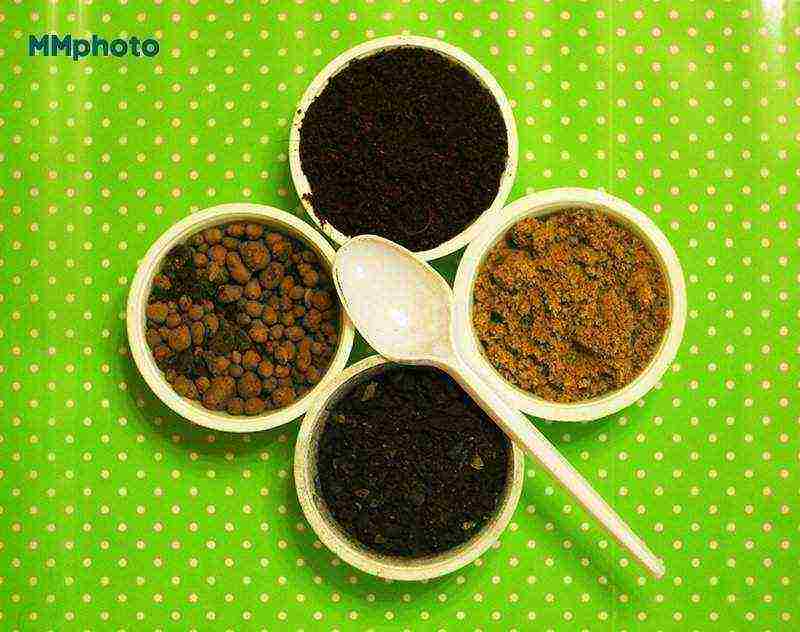Content
- 1 Preparation of seeding equipment for growing a cactus
- 2 Preparation of a seed substrate for growing a cactus
- 3 Preparing cactus seeds at home
- 4 Planting cactus seeds at home
- 5 A few words about picking cacti
- 6 Conditions for growing a cactus
- 7 How to water a cactus at home
- 8 What kind of lighting should be
- 9 Blooming cactus
- 10 How to germinate and sow cactus seeds
- 11 What cactus seeds look like (with photo)
- 12 Before planting cactus seeds, prepare the soil and dishes.
- 13 Reproduction of cacti by seeds in a mini-greenhouse
- 14 Sowing cacti with seeds
- 15 Germination of cactus seeds after planting
- 16 How to plant cacti with seeds in a closed plastic bag (with video)
- 17 What you need to plant
- 18 Seed preparation
- 19 How to care for them to ascend
- 20 How to care after seed germination
- 21 When to transplant. Care in the first year of plant life
- 22 Useful video
Growing rare plants from seeds is a real pleasure for a florist. And to grow such exotic as cacti from seeds is something incredible at all. And, nevertheless, it is not difficult to grow them, subject to certain conditions. And a lot of positive emotions from this process will be provided to you!
Experienced cactusists have special greenhouses with lamps and reflectors for this sacrament. But for the successful cultivation of their own cactus, all these attributes are not necessary, although they are desirable. It is quite possible to grow cacti from seeds without these "bells and whistles", there would be a desire.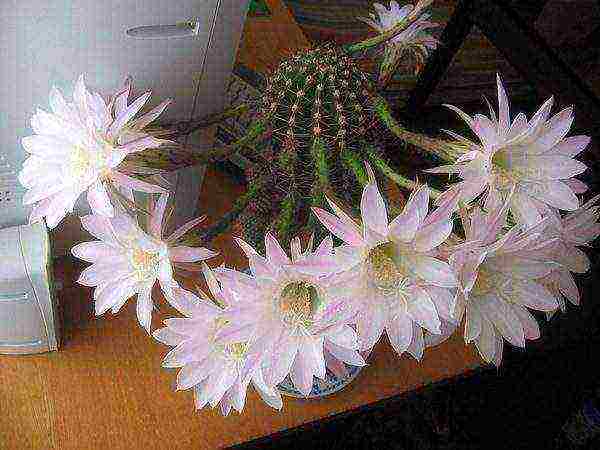
Preparation of seeding equipment for growing a cactus
It is better to sow each species separately, or two species together in small boxes (for example, children's cubes), which are then conveniently put into one common bowl.
You can also sow in one plastic or ceramic dish, at least 3 cm deep, which is divided into cells using vertical partitions. The sowing site of each species is marked with a number or name. Previously, the dishes should be thoroughly washed and disinfected with a strong solution of potassium permanganate, bleach or formalin. It is advisable to boil ceramic dishes. All preparation is carried out on the eve of sowing.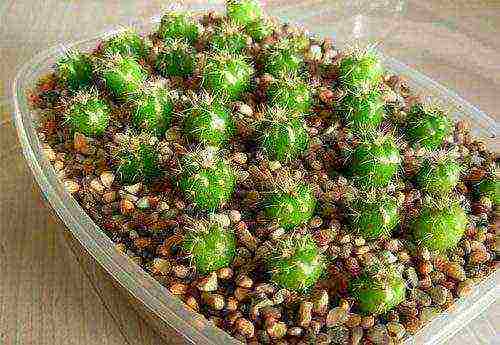
Preparation of a seed substrate for growing a cactus
The sowing substrate should be well air and water permeable, poor in nutrients, able to retain moisture, have a slightly acidic reaction (pH-6) and be sterile. These requirements are met by a mixture of equal parts of sifted sheet soil and coarse washed sand that does not contain lime, with a small addition of sifted peat and charcoal powder. More complex formulations have no noticeable advantages.
We advise you to read
For sterilization, the finished mixture is poured into a saucepan, well moistened, tightly closed with a lid and placed in an oven, where the temperature is maintained at 200-250 ° C. Three liters of the mixture are sterilized for 1-1.5 hours. For a smaller amount of mixture, the sterilization time is reduced.
It is also convenient to sterilize over steam in a pressure cooker pan. After sterilization, the substrate must remain moist. Sterilization is performed the day before sowing. For drainage, use small pebbles, well washed and boiled.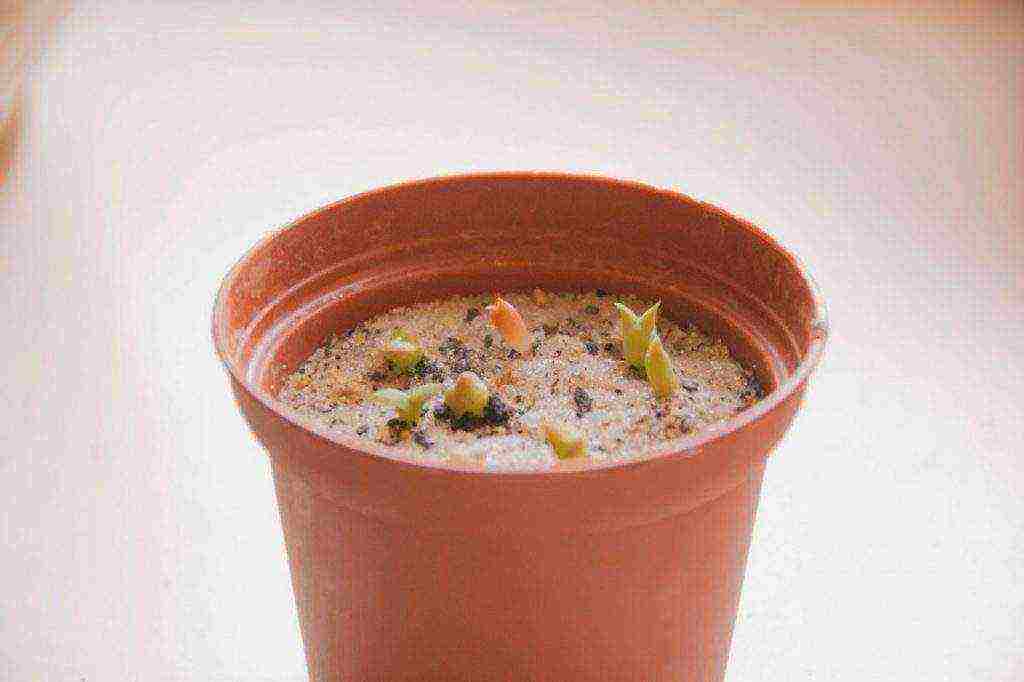
Preparing cactus seeds at home
The process of preparing cactus seeds for planting is similar to many vegetable plants.Soaking them in a solution of potassium permanganate will help speedy germination, and the decay process will be minimized.
It is important to remember that the seeds can be planted one day after soaking. Longer exposure to water will lead to the appearance of long shoots, which, unfortunately, break off easily.
Planting cactus seeds at home
In any pot for planting, three layers should be obtained: the first is drainage, then a layer of prepared soil, which should be compacted to remove the resulting voids, the top layer is looser and shallower, for this the soil must be sieved through a strainer.
Check also our articles
Level the surface, plant seeds using a needle or a small brush, additionally moisten. Above, you need to create a shelter of transparent plastic or glass, put the containers in a warm, bright place. To moisturize, use a pipette or spray bottle, do not overdry. Observe the temperature, which should be within + 25 ° C.
After 2-3 months, it is already possible to pick the seedlings, which contributes to the better growth of thorny plants and the reduction of diseases.
A few words about picking cacti
The grown cacti, on which the first thorns and delicate hairs have already begun to break through, are necessarily transplanted, and together with a lump of earth around the root. A thick drainage layer is arranged in a separate pot, and then the container is filled with a substrate for cacti. The surface of the earth is very carefully leveled, a small depression is made in it and a young plant is placed there. The roots are sprinkled with a thin layer of fertile soil. A small sprout is placed in a warm, bright room, protected from direct sunlight, and watered moderately (as the soil dries up).
Conditions for growing a cactus
If there are no signs of growth, you need to remember the rule: in doubtful cases, do not water! An excess of water is always more dangerous than a lack of it. This is especially important for winter, when most cacti are kept completely dry, of course, when kept cold. Low temperatures are necessary for many cacti to bloom in the next growing season.
This cold but light content is sometimes the greatest difficulty in indoor cacti culture. A cold but dark room is not good here. Many cacti, especially those blooming in spring, require maximum light during rest. Despite the cold wintering, sometimes it is not possible to achieve flowering of cacti. The reason is that in these species we are dealing with young plants that have not yet matured to the flowering stage. Certain cacti, such as melocactus, cephalocereus, espostoa, form flowers only in a certain flowering zone, it is called cephalic. This zone is covered with dense, mostly yellow or brown hairs or bristles, which sit like a cap on the apex or on the side, sometimes in columnar cacti (the so-called lateral cephalic).
How to water a cactus at home
Watering during growth and flowering is carried out abundantly, but the water should not stagnate in the pot. Watered with warm, settled water, but not in any case on the flowers. It is good if you spray with water every day.
During the flowering and budding period, fertilizing (root and foliar) is carried out for two weeks, these are ready-made mixtures for forest cacti rich in potassium and moderate nitrogen content, which is harmful to the roots in large quantities.
What kind of lighting should be
Lighting. Cacti need light at the earliest stage of life - during germination. Of course, like many household crops, direct sunlight will be harmful to them. Therefore, it is advisable to put the tray on a sunny window, but shade it without fail.
We advise you to read
In addition to all these factors, cactus sprouts really need fresh air.How to provide access to the greenhouse? It is enough to make a few small holes in the lid or just move it from time to time to ventilate. The first time this can be done a week after sowing. The lid needs to be removed just for a couple of minutes to remove condensation, but not to overcool the little "cactus". The lid should be tightly closed at night.
Blooming cactus
Flowers can form either in the area of the top or at the base of the stem of the cactus, this is an important feature when determining. They do not last long on the plant, sometimes only a few hours. Some cacti have a peculiar feature - to bloom at night, because in the conditions of their homeland they are pollinated by moths or bats. Flowers evaporate a lot of moisture, so the plant cannot afford such luxury for a long time.
Thanks to the thorns, many cacti are very attractive and not in bloom. They are not overly demanding. It is enough to recall the conditions in which cacti live, for example, in the mountains, and it becomes clear why they need to be brought up rather harshly. Many species benefit from significant differences in night and day temperatures and produce stronger thorns and more abundant flowering. When buying plants, it is recommended to choose species with especially beautiful spines.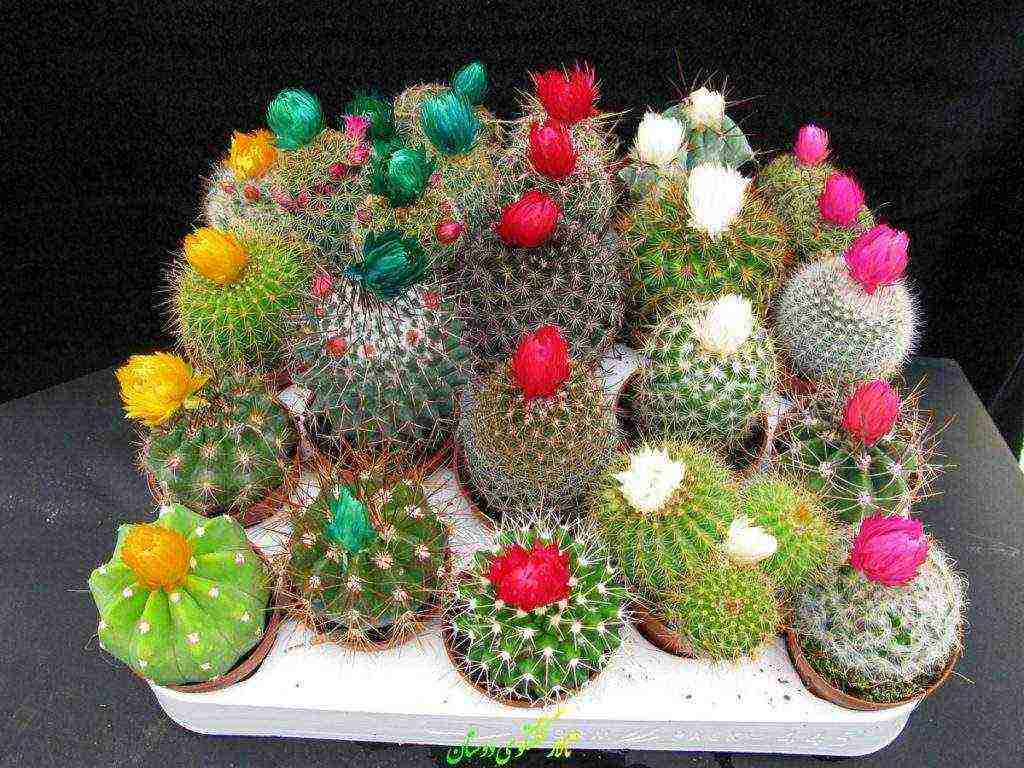
Growing cacti from seeds in the video.
Usually, the cultivation of cacti from seeds is practiced in breeding work, since these plants reproduce well in a vegetative way. But it is quite possible to grow cacti from seeds and at home, there is nothing complicated in this agrotechnical procedure. You can learn how to grow a cactus from seeds from the proposed material. It tells about the necessary tools and equipment, the preparation of planting material and the organization of care for seedlings. A description of the entire reproduction process by seedlings will allow each grower to repeat this work.
Before growing cacti from seeds at home, you need to prepare everything you need and be patient, since the initial growth and development of these crops will be very slow. Cacti grown from seeds at home can first bloom only after 5-6 years. Otherwise, propagating cacti by seeds is not very difficult.
How to germinate and sow cactus seeds
Before planting a cactus from seed, you should make sure that this variety or genus does not give rise to genetic mutations. If it retains all the varietal characteristics, then the process will be fun. The only thing, before sowing cacti with seeds, you must follow a few basic rules. So the seeds of cacti germinate, in accordance with the nature of the growth of these plants in general, slowly; seedlings also develop slowly. In addition, while cactus seeds need moisture and warmth to germinate, on the other hand, cactus seedlings are very susceptible to fungal diseases. Therefore, when sowing seeds, it is necessary to maintain the required humidity and temperature and at the same time strive to prevent the appearance of fungal diseases. How to germinate cactus seeds is described in detail in this article later on the page.
Sowing cactus seeds on a larger scale or propagating particularly difficult, slow-growing cacti, which often have very small seeds, should be carried out only by experienced amateur cactus growers. The information required for this can be found in the specialized literature. However, even novice hobbyists can try to propagate by seeds suitable types of cacti - for example, fast-growing columnar cacti - with simple means. Seed propagation of cacti is an interesting sight to observe, besides, there is always a special attitude towards a plant grown with your own hands from seeds. Therefore, some recommendations are given below for sowing cactus seeds.
What cactus seeds look like (with photo)
Specialty stores offer a wide variety of cactus seeds. Usually, for their first attempt, beginners choose either a mixture of seeds of different varieties, or the seeds of fast-growing columnar cacti or the seeds of species that bloom several years after planting, such as rebutia. You need to know about how the seeds of cacti of the species and variety you are interested in look like, otherwise you cannot avoid disappointment in the future.
Of course, you can also sow seeds from another cactus lover. For sowing, seeds should be used that have been stored for no more than one to two years. To prevent possible damage to seedlings by fungal infections, the seeds must be cleaned from possible residues of fruit pulp before sowing.
To do this, the larger seeds are poured into a tea strainer, and the smaller ones into a linen bag and thoroughly washed in warm water, then sprinkled on paper and dried.
See how cactus seeds look like - the photo shows the planting material of different groups of these plants:
Before planting cactus seeds, prepare the soil and dishes.
First, we prepare the soil and dishes. Cactus seeds can be sown in low wide pots or bowls, for example, made of styrofoam. Before planting cactus seeds, the dishes are washed with hot water. A convex clay shard is placed on the drainage hole, which, if necessary, can be made in the bottom of the bowl with a pencil. Then the container is filled 2/3 of the soil mixture for cacti, which should be especially loose and, if possible, contain more coarse sand or perlite.
Steamed, and therefore well sanitized, potting soil provides the best protection against fungal diseases, but this is not necessary. A layer of broken brick, crushed basalt (lava) or coarse sand is poured on top of the soil with a layer of 0.5 cm. This material is first sieved to a grain size of 1-2 mm, then washed to remove all small dust-like particles, dried and then scattered over the soil surface in a bowl. As a result, this layer will not be a breeding ground for accidentally germinating pathogens.
Reproduction of cacti by seeds in a mini-greenhouse
The propagation of cacti by seeds in a mini-greenhouse has a lot of advantages, since favorable conditions are created for the germination of planting material. The seeds of most cacti germinate especially well at temperatures between 20 and 25 ° C. Lowering the temperature to 15 ° C at night is often beneficial, but cooler conditions or temperatures above 35 ° C slow or stop seed germination altogether.
It is easiest to maintain the desired temperature in mini-greenhouses for growing seedlings, along the bottom of which a special low-power heating electric cable is laid.
The most convenient mini-greenhouses with a thermostat that allows you to regulate the temperature, however, the need for this arises only when there are strong temperature changes in the room.
Of course, additional heating is not necessary if the mini-greenhouse is located in a heated living room, for example, on a windowsill under a central heating battery, where the required temperature is constantly maintained. Thanks to the closed lid, a higher air humidity is also achieved and maintained inside the greenhouse. Since cactus seeds need light for germination, the mini-greenhouse must be placed in a bright place, for example, on the windowsill of a north or east facing window.
However, it should not be in the sun, that is, on a sunny south or west window, since intense solar radiation very quickly heats the air inside a small enclosed space to critical values. Although light is desirable for cactus seeds for germination, it should be soft, not bright sunny.
Sowing cactus seeds
When sowing, cactus seeds must be evenly distributed over the surface of the substrate.
For this, a sheet of paper is folded in half, the seeds are poured into the formed groove, after which, by lightly tapping on paper slightly inclined to the bowl, the seeds are evenly poured one at a time onto the soil surface.
Since cacti develop slowly and grow better in the community, seeds are sown relatively densely. As a guideline, it can be indicated that about 20 cactus seeds are sown on the soil surface in a 2 x 2 cm bowl.
After sowing cacti with seeds, they are lightly pressed into the soil using any object with a smooth surface, such as a matchbox. Since the seeds of cacti need light for germination, they are not sprinkled with soil on top.
After that, the seeds and substrate must be moistened. Of course, this cannot be done from a watering can, since in this case the seeds will be washed off the soil surface with a stream of water. Therefore, bowls with sown seeds are placed in a container filled with settled water and kept there until the substrate is well saturated with moisture to the uppermost layer. For the prevention of fungal diseases for irrigation, you can use a 0.05% solution of quinosol (1 tablet per 2 liters of water). Quinosol is a mild disinfectant. Finally, the sowing bowls or pots are placed in a mini-greenhouse, where, thanks to the transparent plastic lid, the required substrate moisture will be maintained.
Germination of cactus seeds after planting
During germination after planting cactus seeds, the substrate should not dry out. Temperature is best controlled with a minimum-maximum thermometer.
Many cactus seeds germinate within two weeks. It is interesting to observe how small green balls begin to appear on the surface of the soil and two well-marked cotyledons develop, between which a cactus stalk is later formed.
When the majority of the seeds have germinated, the lid of the mini-greenhouse is slightly lifted from time to time to reduce the humidity in the air, and with it the risk of fungal infection. After three to four months, bowls with seedlings can be removed from the greenhouse. Now they need to be placed in a bright and slightly sunny - however, not in bright sun - place; since under natural conditions, cactus seedlings grow in the light shade of adult cacti or under the protection of higher surrounding vegetation.
Seedlings are best pressed for several months to develop in the bowl where they germinated. Now, between the next waterings, the soil in the pot should dry out slightly, however, despite this, the seedlings need to be watered more often than adult cacti, since a relatively looser soil mixture is used for sowing seeds, and the roots of the seedlings are not yet very well developed. Watering should continue from the bottom. In order for the seedlings to grow healthy and the substrate does not alkalize, potassium phosphate (1 g per 2 L of water) can be added to the irrigation water.
Picking.
When the seedlings begin to form a dense pillow (curtain) in the bowl, they must be cut into fresh soil.
In this case, the substrate in the planting bowl or pot must be dry, then it easily disintegrates and allows you to remove the seedlings without damage. Young plants, which by this time have a diameter of about 0.5 cm, are not planted in separate small pots, but are planted in large quantities in larger pots or bowls.
The juvenile planting vessel is filled with a relatively dry conventional cactus potting mix. Then, with a pencil or a pointed stick, make a depression, place a seedling in it and carefully pour soil from all sides.
Seedlings are planted from each other at a distance equal to approximately three times the diameter of young plants.
After transplanting, the seedlings are kept in a warm, shaded place; they are carefully watered not immediately after transplanting, but only after a few days, when the possibly damaged roots are overgrown. When the seedlings take root in fresh soil - after about a week - they are again transferred to a bright, slightly shaded place from direct sunlight. Plants now grow and develop relatively quickly and without any problems.
How to plant cacti with seeds in a closed plastic bag (with video)
Some cacti growers achieve good results using a simple method of sowing cactus seeds. Before planting cacti with seeds, the pots or bowls are filled, as described above, with a well-steamed potting soil mixture, and covered with a layer of sterile material, such as sand, perlite, crushed basalt or pumice. Then cactus seeds are sown on the surface of the substrate and the crops are thoroughly watered from below, adding any fungicidal preparation, such as quinosol, to the water.
After the excess water drains from the pot, it is placed inside an airtight (no holes) plastic bag, tied and placed or suspended in a bright, but not sunny place.
Since moisture in a closed plastic bag cannot evaporate, crops do not need constant monitoring and can be left to themselves for a quarter of a year. The decisive factor for the successful production of seedlings with this method of sowing is the elimination of fungal infections.
After three to four months, the bags are opened, the substrate is slightly dried in the bowls and the seedlings are dived, as described above. This simple method of sowing cacti is definitely worth trying, first of all, in the case when you have received - for example, from a friend, an amateur cactus grower - a lot of seeds of some particularly hardy species.
See how to properly propagate a cactus with seeds - the video demonstrates all the complex technical coins of sowing, picking and organizing the care of seedlings:
There are many exotic species among domestic plants. Some are large, while others eat small insects. However, among them there is one unconditional leader - the cactus. This flower studded with needles is present in almost every apartment. Many people find it very attractive especially during the flowering period.
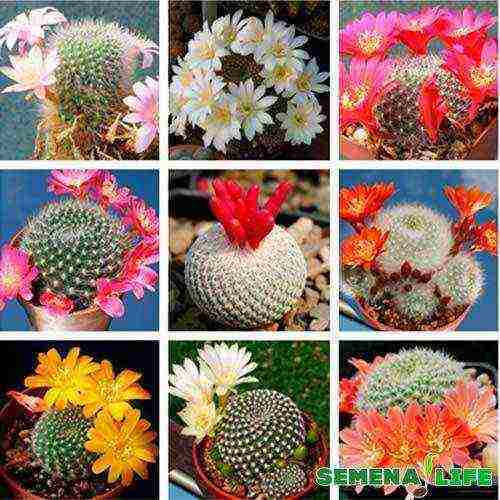 It is easy to grow a cactus from seeds by yourself
It is easy to grow a cactus from seeds by yourself
They also love the cactus for its vegetative way of reproduction. If desired, it is not difficult to bring out a huge plantation at home.
Growing cacti from seeds has some peculiarities, but with a more detailed study on the SEMENA.LIFE website, you can figure out all the nuances yourself.
Preliminary work is an important step towards your own agricultural production. You will need to purchase equipment, study the relevant material and be patient. Under ideal conditions, the flowering of the first cactus occurs 5 years after planting.
Germination and planting of cactus seeds in the ground
Only proven seeds from the most successful plantations are selected. The process of growing a cactus is long, so if there are defects in the plant, disappointment will be strong. There is no point in saving money on seed purchases.
 The first cactus will not bloom soon
The first cactus will not bloom soon
The seeds themselves must be washed in an appropriate bowl. We place especially small species on a gauze cloth and douse them with warm water. Age remains an important point. You only need to look after fresh material for growing. The best choice is up to two years.
When germinating, it is worth controlling the temperature and humidity according to the requirements of the selected type of cactus. They differ from each other, which makes the whole process difficult. The needs of the sprout in water are taken into account. For adult species, moisture is not so critical, but for a germinated seed it is vital.
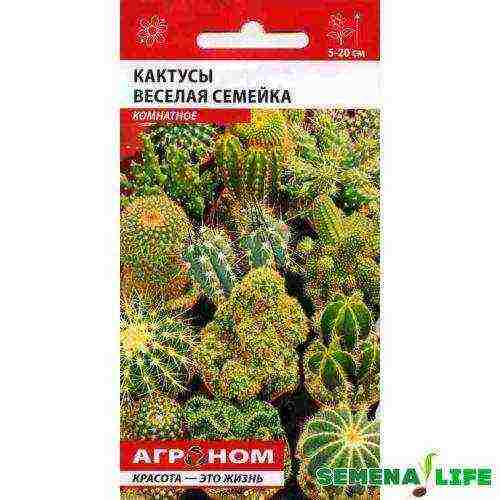 Cacti Cheerful family
Cacti Cheerful family
We combine the soil poured into a wide pot of perlite and coarse sand. The container needs to be filled more than half, but not to the brim. To exclude the defeat of the cactus by the fungus, it is worth considering the drainage system to drain excess water. It is advisable to make several holes at the very bottom so that most of the water is retained in the soil.
On top of the soil, you need to lay a dense layer of fine brick, coarse sand or basalt. This protective layer will prevent weeds from entering the fertile land. Cacti require increased protection from fungus and other dangerous plants, which will multiply due to them.
The very process of growing a cactus
We are building a mini-greenhouse at home. Cacti, due to the specifics of their growth in the wild, are accustomed to hot conditions.
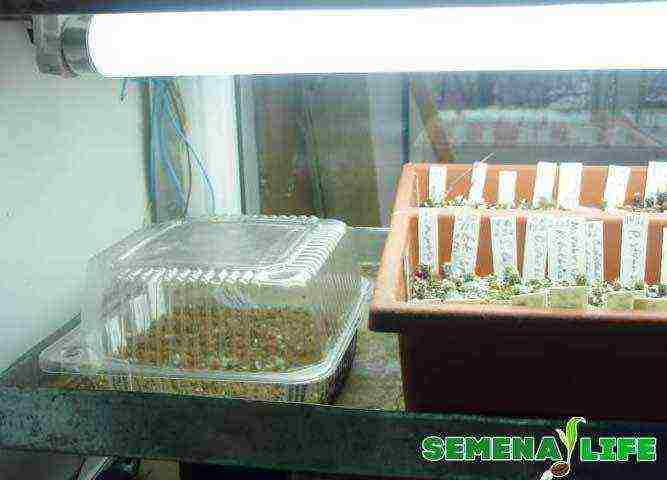
Roughly the same conditions need to be created inside a homemade greenhouse. All breeders consider the optimum temperature to be up to +25 ° C. From deviations, variation within 10 ° C is allowed. Even useful in some cases can be considered a temperature of +15 ° C, but not lower.
Important: breeders are advised to equip mini-greenhouses with their own heaters and thermostats. Can't trust room temperature to control cactus growth. Even a minimal draft slows down the growth processes due to air cooling, only closed greenhouses with heating elements equipped in them.
Other requirements for a mini greenhouse:
- placement of the greenhouse is allowed only on the sunny side of the room
- direct sunlight is contraindicated
- when heating the air inside the structure with seeds, the room temperature is taken into account
- excess moisture must evaporate freely from the pallets
The very process of sowing seeds
Pour the seeds tightly to each other. If you take an area of 2 by 2 cm, then you should get up to 20 grains. The cactus is used to growing in families. Thanks to small groups, growth should be more intense than with a lone planting. After placing the grain on the soil, press it lightly with a finger or other medium-soft object.
The soil does not fit on top of the seeds. The sun's rays during the day should fully illuminate the entire crop area. But besides light, you also need water. It is not poured with an ordinary watering can. Breeders take the entire container of cactus and place it in a container of water. Only when the top layer is impregnated, the moistening process can be considered complete (water must flow through the drainage holes at the bottom).

Breeders' tip: 0.5% quinosol will help protect youngsters from fungal attack. To prepare the composition, one tablet is dissolved in 2 liters of water. Excessive use of chemicals is not recommended.
Watching the growth of a cactus
The cactus itself from the seed will appear no earlier than two weeks. All this time we water the earth or moisten it in any other convenient way. The moisture in the soil constantly supplies everything the plant needs, thereby accelerating its growth.
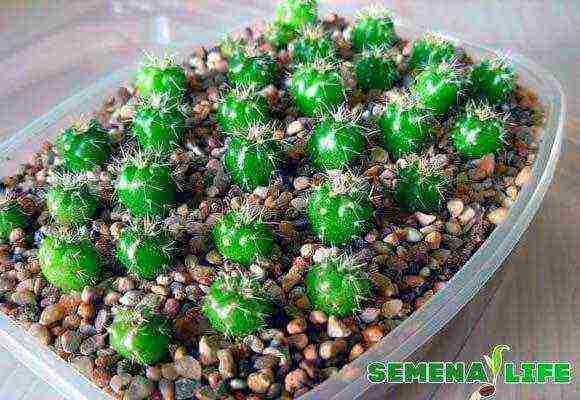 Don't forget about soil moisture
Don't forget about soil moisture
After four months, the need for a mini-greenhouse disappears. Now the cactus is taken out of the shelter to its usual place in the apartment, but with enough daylight. The window sill is not suitable due to the risk of ultraviolet rays entering the plant in direct sunlight. It will be best to put the pot on the table near the window.
It will take several more months for the cactus roots to form. Subsequently, it can be transplanted to any other land. An already formed adult sprout does not require abundant watering. Sometimes it is recommended to add potassium phosphate to irrigation water for prophylaxis.
There are many cactus lovers in the world, but not everyone knows how to propagate and grow them from seeds at home. In fact, there is nothing difficult here, however, it requires certain skills. Another problem is that the seeds are not planted correctly and, in the end, they simply rot in the ground.
One of the most problematic questions is: "How to properly grow a cactus from seeds?" In this article, we will try to describe in as much detail as possible the entire process of preparation and cultivation, as well as how to monitor and care for future plants. Let's get started!
What you need to plant
Before telling how to plant seeds, you should prepare everything you need so as not to be distracted in the process. We will need:
- Cactus seeds
- Land for landing
- Capacity, where we will plant
Now, let's briefly dwell on each of the points.
Seeds
You can get our planting material in two ways - on your own or buy in a store.
In the first case, you will need to wait for your favorite cactus to bloom and a box of seeds will remain in place of the flower. The disadvantage of this method is obvious and not one - you need to wait a long time and the lack of uniqueness. If it is clear about the waiting time, then “uniqueness” means that you can grow several more cacti of the same type from the seeds obtained. Although, to gain experience in growing, this option is also fine.
The second method is the most preferable. You don't need to wait, you can go to a flower shop at any time and buy seeds of any kind, even rare.
Earth
With the land, everything is also simple. The soil can be made on your own, but this is not recommended for growing seeds, as it requires certain knowledge and will take a certain amount of time. You can independently prepare the soil for older cacti, but for growing seeds, it is better to purchase a special, already prepared soil in the store. It will already contain all the necessary fertilizers, trace elements and other components.
Remember to tidy up the soil before planting. To do this, you can fill it with a manganese solution and let it dry completely, or pour it onto a baking sheet and send it to the oven for 5-10 minutes, at a temperature of 100-120 degrees.
Capacity
For planting, we need a small greenhouse with a transparent lid. You can find it in a flower shop, but you can also save money. What is needed for this? Cake packaging! Most cake containers now have a transparent lid and a pallet with small sides. This will be enough for us.
Another greenhouse can be replaced with a plastic "disposable" (as it is called) box, the lid of which can be on plastic "loops" or removable. You can find it in the same place where plastic cups, plates, forks, etc. are sold. They are also quite common in supermarkets - they usually pack cookies, straws and other things.
Seed preparation
It is imperative that the seeds should be treated and disinfected before planting. This can be done with a weak solution of potassium permanganate. The seeds should be soaked in the solution for 9-10 hours, but not more than 12! So, mark the time, or better, so as not to forget - set the alarm.
Disembarkation
After everything is ready, you can start sowing seeds. We take our greenhouse and fill it with earth. The layer should be no more than 5 cm. Some people prefer to lay drainage on the bottom, which, in principle, will not be superfluous, but it is possible without it. The poured earth now needs to be watered - it must necessarily be boiled water with a temperature of 40-45 degrees. Water evenly, avoiding overflow, otherwise you will have to reap when excess moisture evaporates.
Further, when the ground is wet, it must be leveled and shallow holes made for seeds. The distance between them should be 1.5-2 cm. The holes can be made with a toothpick or a match. Now, you can start seeding. We place each seed in the finished hole, but do not fall asleep with earth. When finished, the greenhouse should be covered with a lid or cling film, and placed on the windowsill.
During the first week, you will see your future cacti begin to sprout.As soon as the first thorns appear, the greenhouse can be opened slightly so that the plants breathe fresh air.
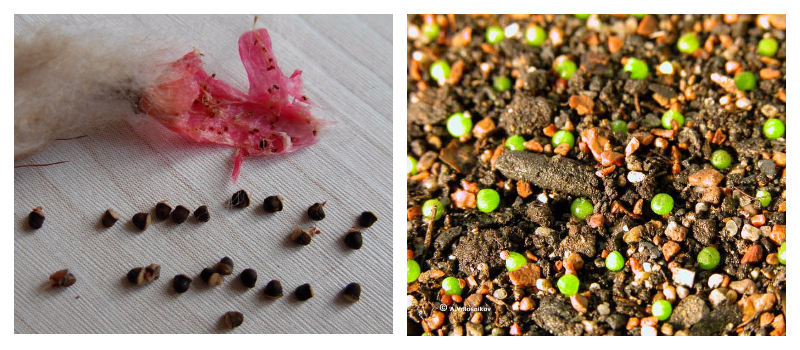
How to care for them to ascend
In order for our planted seeds to sprout, certain conditions must be observed, namely:
- Watering
- Temperature conditions
- Lighting
A little more detail on each of these 3 points.
Watering
During the growing period, it is imperative to ensure that the soil is moist and do not let it dry out. But, it should also not be overused, otherwise the seeds will simply rot due to excess moisture. Check moisture with your finger. If the soil is slightly damp, but more dry, then it should be watered.
Just do not try to water from a bottle or mug. The best option is a pipette or a nebulizer (spray bottle). Using a pipette, moisten the soil around each seedling. Yes, this will take time, but you can use a spray to save it. It covers a much larger area and moisturizes the entire earth at once. Remember that you need warm water!
Temperature conditions
No matter what time of year you plant the seeds, for their correct growth, you must maintain the right temperature. The normal and most suitable temperature is 23-25 degrees Celsius. At night, the greenhouse can be moved to a slightly cool place, with a temperature of 13-18 degrees - it will even be useful.
Lighting
As for lighting, young plants should receive it in full, so when choosing a windowsill, make sure that a large amount of light, both daytime and sunlight, falls on it, but at the same time, avoid direct sunlight. Additionally, you can use artificial lighting devices.

How to care after seed germination
As soon as the first thorns appear, the greenhouse can be opened for ventilation. During this period, it is important not to spoil anything. In addition to spraying from a spray bottle, you can add a little watering from a watering can. Soil moisture, check everything yourself and do not let it dry out completely.
As for the temperature, it remains the same - 25 degrees, but gradually, it can be increased to 30. At night, it is also possible (even necessary) to transfer cacti to a cooler place.
As for the lighting, it also remains unchanged. The only thing is, you can remove artificial lamps if you have used them.
In addition to all of the above, young shoots can be fed with fertilizers, albeit in small quantities. To do this, take a special top dressing at the flower shop. The main thing is that it contains a large content of potassium, phosphorus and calcium, but nitrogen should be in scanty amounts. Feeding with fertilizer can be done once every one and a half to two weeks - this will be enough.
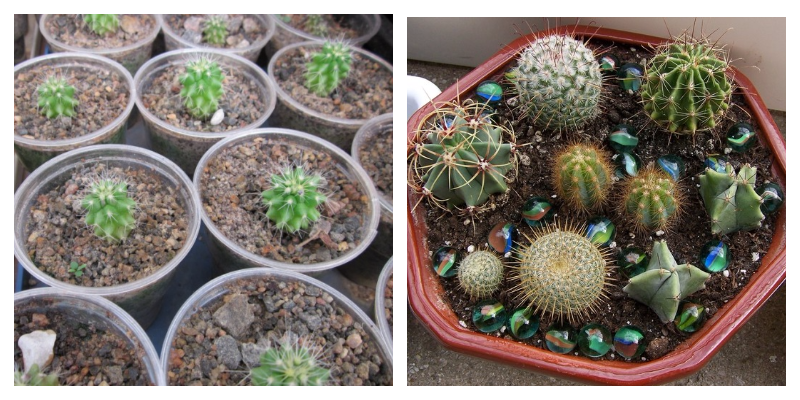
When to transplant. Care in the first year of plant life

After 3 months, the seedlings can be planted for the first time. To do this, you need small pots or, for the first time, plastic cups with a volume of 0.5 liters. On the bottom of the cups, be sure to make several holes, like on pots. If the planter is without holes, observe the watering regime. (water a little and not often). So, let's start transplanting.
- At the bottom of each pot, pour a layer of drainage (expanded clay, gravel, crushed brick). After that, start pouring the soil. Use the same land as when landing, the other is not needed yet. Fill the pots almost to the top with soil, leaving 1 to 2 cm of soil. In the middle, you need to make a depression, you can use your finger. This is necessary in order to place our cactus there.
- Now, from our greenhouse, together with a lump of earth, we take a seedling and transfer it to a "new home". He carefully tramples everything with his fingers, after which, the soil can be fertilized and watered a little. All the same should be done with all the remaining seedlings.
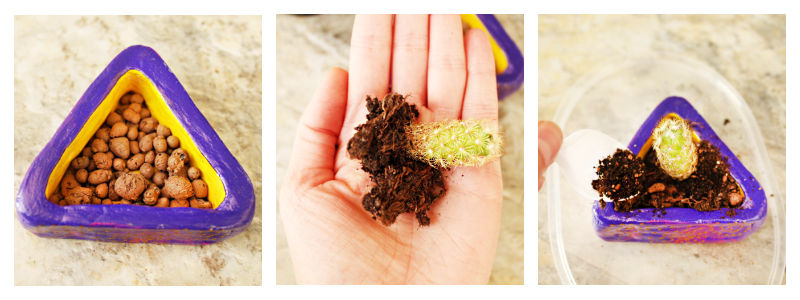
As for leaving in the first year, there are no difficulties here. The most important thing is to continue to care properly.The only thing you should remember is that gradually, the plant needs to be accustomed to proper watering, that is, to the same as in older plants. You can start doing this after about six months. Do not forget about the feeding, which must be carried out before September, and, of course, during the dormant period, provide the plant with peace, and do not disturb it again.
After the first year, the cacti will need to be transplanted into larger pots, and later on, the transplant should be done as they grow.
Read more about cactus care
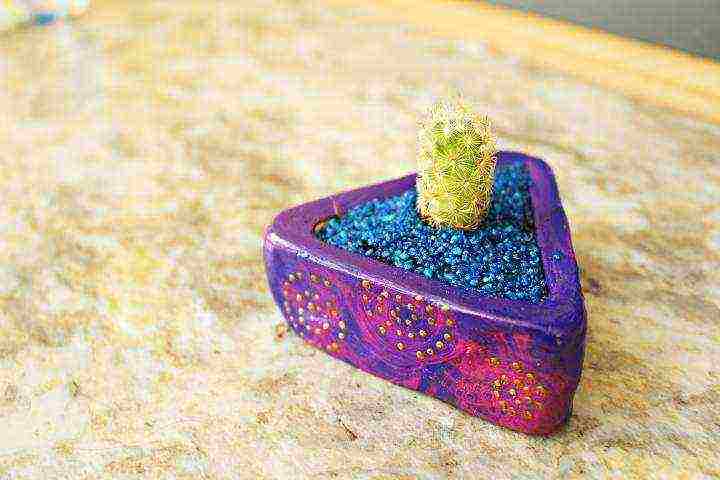 Option for decorating pots with decorative sand
Option for decorating pots with decorative sand
Useful video
And that's all! Good luck in growing!
